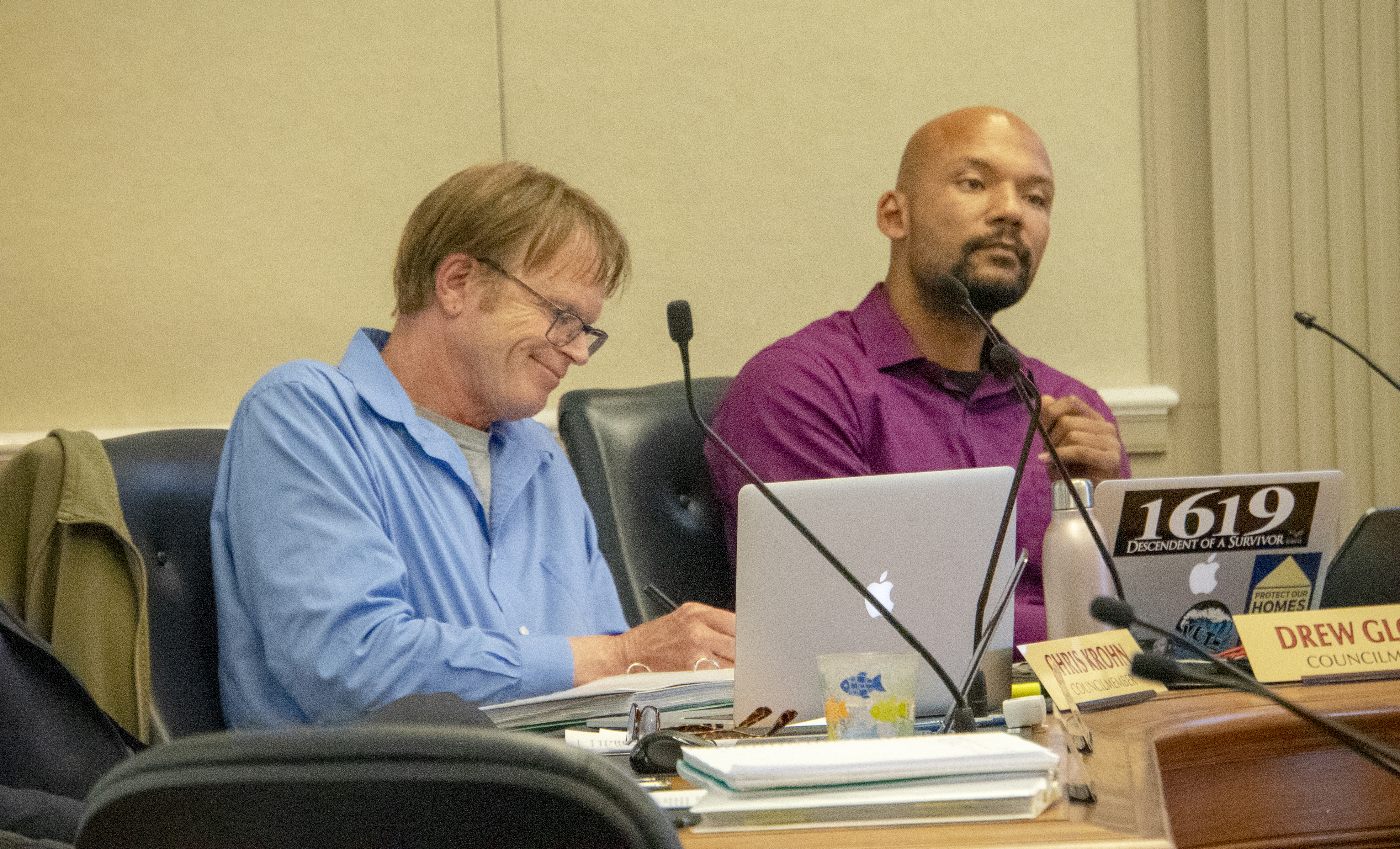The City of Santa Cruz now has a projected $3.9 million deficit. The Santa Cruz City Council on Tuesday took major steps toward balancing the budget. Hear what cuts and revenue strategies the city is considering before the final budget adoption, expected June 11. Also, we hear a letter to the editor about our needle exchange episode.

TRANSCRIPT
Kara Meyberg Guzman: I’m Kara Meyberg Guzman. And this is Santa Cruz Local.
The City of Santa Cruz has a multi-million dollar deficit. It’s a little bigger than it was at the beginning of May. And what it means for you is that you’re going to see some cuts to city services.
On Tuesday night the Santa Cruz City Council held the second of three expected budget hearings. We got some clarity on where you’ll be seeing cuts in city spending. I’ll break it down for you in a moment.
But first, in case you missed our previous episode on the budget, I’d suggest you listen to that as well. It’s episode 19, What you should know about the city’s budget. We learn why we have a deficit, and why it’s more than doubled in the past year. If you’re listening to us on KSQD, you can find that episode on our website, santacruzlocal.org, or anywhere you find podcasts.
OK. So, the first thing you should know is that the projected deficit for the next fiscal year is now $3.9 million, up from $3.2 million at the beginning of May. That’s because at the May 8 meeting, the council added some possible spending. For example, the council is considering adding $175,000 for assistants for city council members. Mayor Martine Watkins and councilmembers Donna Meyers and Cynthia Mathews voted against the addition of assistants. Councilmember Drew Glover, however, was pushing for it, saying that city council members are paid half-time but expected to work full-time. He said he already has a full-time job, and an assistant would make him more effective.

Also, on Tuesday, the council approved reducing the city’s cannabis business tax to match that of the county. So that $200,000 drop in expected revenue is another reason the deficit grew.
The city also expects to be spending more than it projected a few weeks ago, when the budget was first drafted. For example, labor negotiations are proving to be more expensive than initially thought – at an additional cost of $595,000 to the general fund. There’s another $500,000 in new liability claims and another $300,000 to $600,000 in added city attorney costs.
OK. So, the good news is, on Tuesday the council made some headway in reducing the $3.9 million deficit to about $800,000. It’s not a balanced budget yet, but it’s close.
Some cities like San Jose have it in their charter that they must balance their budget. Cities like Santa Cruz aren’t required to balance their budget. But, Santa Cruz would have to face consequences. If the city doesn’t fix its deficit, then the deficit will continue to grow. Then the general fund’s reserve, and the city’s trust funds would be gone within three years. The problem becomes harder to fix, according to City of Santa Cruz Finance Director Marcus Pimentel.
OK, now here’s the bad news. It’s the difficult cuts that the city has to make to balance the budget. Note, this is still preliminary until the council approves the budget, which is expected at the June 11 meeting.
I’ll start with two big ticket items. The Santa Cruz Police Department is going to cut most of its security patrol contract with First Alarm, for a savings of $237,000. That means that upper Ocean Street, Harvey West Park and the Wharf will no longer see special neighborhood patrols from security guards. Those security guards don’t have the authority to issue tickets or force anyone to leave, however, they can act as eyes and ears for the police department, and can radio in to the nearest police officer if they need backup.
The Planning and Community Development department will see a $540,000 cut to its consultant spending. That could mean longer wait times in the building department and some delay to long-range planning projects.
The city will also be reducing irrigation at DeLaVeaga Golf Course. The city spends $750,000 a year to water the golf course, and it’s looking at an aggressive plan to get the golf course to be self sufficient. However, doing so a delicate task, since browning out too much of the course will drive away the players and reduce revenue. Also, the water department is counting on revenue from the golf course, and would likely have to raise fees if it dropped to zero.
In the meantime, the city has raised rates for golfers wanting to play on high demand weekends, like the U.S. Open. By April, all golf rates will increase.
There were a few dozen other smaller cuts, and some others that the council delayed considering until the June 11 meeting, like the cuts to community programs.
We’ve posted the full list on our website, santacruzlocal.org.
484573205292019044751532Also: The city is looking at new ways to increase revenue.
For example, the Santa Cruz Fire Department is looking at billing your insurance companies if you get paramedic treatment. Your insurance won’t be charged for fire calls or ocean rescue. It’s only for things that an ambulance medic would do, like defibrillation. According the Fire Chief Jason Hajduk, this revenue model has become a common practice at fire departments throughout the state. It’s still unclear how much money these strategies might raise, since the council still has to decide the details.
Also, the cost of residential and guest parking permits outside the downtown area will increase by $5, which will raise about $50,000 for the city.
Also, it wasn’t mentioned on Tuesday, but at the May 8 city council meeting the council discussed pursuing some sort of tax increase, such as a hotel visitor tax, in the next election.
Again, the council is expected to approval a final budget at its June 11 meeting. So if you have anything to say, I’d urge you to email the city council by June 7 to [email protected], or show up to the meeting.
Before we go, I wanted to touch on a few quick things from about our last episode, on what we learned from looking at the county’s needle exchange. We got a lot of feedback and ideas for follow up stories, so to those of you who wrote or called us, thank you.
A brief clarification. We reported that in the past two years the county has doubled its detox beds from eight to 16. We neglected to mention that the county has also nearly doubled the amount of residential treatment that it’s offering for drug addiction. That’s thanks to a program that allows the county to bill the state’s Medi-Cal program for addiction treatment.
Also, here’s an audio letter to the editor from Santa Cruz Local listener Katrina Leestma. She is a nurse at Encompass. She is part of the medication assisted treatment program and she administers suboxone to people with opioid addiction. Suboxone is a medication that reduces cravings and withdrawal symptoms of opioids. She said she wishes our episode delved deeper into the treatment for opioid addiction.
KATRINA LEESTMA: Suboxone is very, very effective. It’s extraordinary to see how it gives people really a second or third life. It may take them to find the appropriate things that they particularly need, but suboxone is just a small piece of the bigger picture. But once they have that they have a steep, nearly vertical recovery ahead of them in many cases.
KMG: That’s it for this episode. If you haven’t signed up for the Santa Cruz Local email newsletter yet, you can do so on our website, santacruzlocal.org. Follow us on Twitter @theSClocal. You can find our episodes anywhere you like to listen to podcasts.
Thanks to Podington Bear, at soundofpicture.com, for the music.
I’m Kara Meyberg Guzman. Thanks for listening to Santa Cruz Local.
Kara Meyberg Guzman is the CEO and co-founder of Santa Cruz Local. Prior to Santa Cruz Local, she served as the Santa Cruz Sentinel’s managing editor. She has a biology degree from Stanford University and lives in Santa Cruz.





